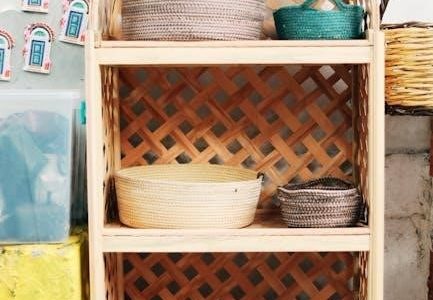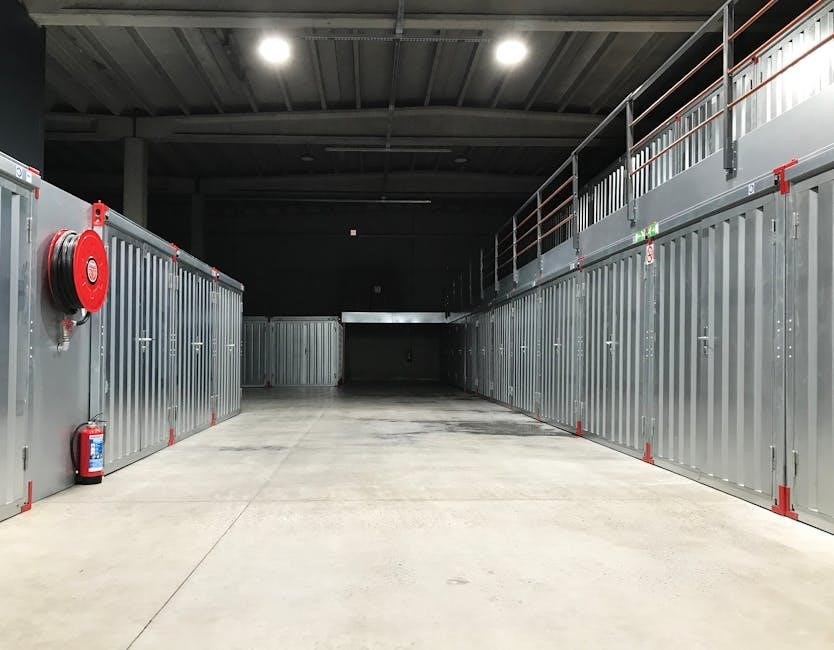
self storage unit size guide
A self-storage unit size guide helps determine the ideal space for your belongings. Units range from small (5×5) to large (10×30), ensuring efficient storage solutions tailored to your needs.
1.1 Importance of Choosing the Right Storage Unit Size
Selecting the right storage unit size is crucial for maximizing space, budget, and efficiency. Overestimating may waste money, while underestimating risks damaging items due to overcrowding. The correct size ensures belongings fit comfortably and remain accessible. It also prevents unnecessary rental costs for unused space. By aligning the unit size with your needs, you optimize storage and avoid potential issues like moisture buildup or structural strain. Proper sizing is key to a stress-free storage experience, ensuring your items are secure and well-organized for their entire storage duration.
1.2 Overview of Common Storage Unit Sizes
Storage units come in a variety of sizes to accommodate different needs. The smallest units, such as 5×5 (25 sq. ft., 200 cubic ft.), are ideal for storing small items like boxes or seasonal decorations. Medium units, like 5×10 (50 sq. ft., 400 cubic ft.), suit studio apartments or small furniture. Larger units, such as 10×10 (100 sq. ft., 800 cubic ft.), can hold the contents of a one-bedroom home, while 10×20 (200 sq. ft., 1,600 cubic ft.) and 10×30 (300 sq. ft., 2,400 cubic ft.) units are perfect for entire households or large items like vehicles. Specialty units are also available for unique needs, ensuring there’s a size for everyone.
Common Self Storage Unit Sizes
Self-storage units range from small (5×5) to large (10×30), offering versatile options for storing personal items, furniture, appliances, and even vehicles, catering to diverse storage needs.
2.1 Small Storage Units (5×5 to 5×10)
Small storage units, ranging from 5×5 to 5×10 feet, are ideal for storing small items like boxes, seasonal decorations, or personal belongings. A 5×5 unit, equivalent to a closet, fits 200 cubic feet, perfect for boxes or a few pieces of furniture. The 5×10 unit, offering 400 cubic feet, can hold items from a studio apartment, such as a mattress, dresser, and small appliances. These compact spaces are cost-effective and suitable for short-term or minimal storage needs, ensuring efficient use of space for smaller volumes of belongings.
2.2 Medium Storage Units (10×10 to 10×15)
Medium storage units, ranging from 10×10 to 10×15 feet, are versatile solutions for storing larger items. A 10×10 unit (100 sq.ft., 800 cu.ft.) is ideal for furniture, appliances, and boxes from a one-bedroom apartment. The 10×15 unit (150 sq.ft., 1,200 cu.ft.) accommodates contents from a two-bedroom home, including larger items like sofas and dining tables. These units are perfect for short-term moves, seasonal storage, or decluttering projects, offering ample space without excess, making them a practical choice for balanced storage needs.
2.3 Large Storage Units (10×20 to 10×30)
Larger storage units, from 10×20 to 10×30 feet, are designed for substantial storage needs. A 10×20 unit (200 sq.ft., 1,600 cu.ft.) can hold furniture and belongings from up to four rooms, ideal for home renovations or large moves. The 10×30 unit (300 sq.ft., 2,400 cu.ft.) accommodates entire households, vehicles, or business equipment. These units are perfect for long-term storage, offering ample space for bulky items, ensuring everything fits securely and remains accessible, making them a robust solution for extensive storage requirements.
Factors to Consider When Choosing a Storage Unit Size
Key considerations include the type and quantity of items, space required for furniture and appliances, and budget constraints to ensure cost efficiency and optimal use of space.
3.1 Type and Quantity of Items to Store
The type and quantity of items to store are critical in determining the ideal storage unit size. For instance, smaller units like 5×5 are perfect for boxes, seasonal decorations, or small furniture, while larger units such as 10×20 can accommodate entire households, including appliances and large furnishings. Assessing the volume of your belongings ensures you select a unit that prevents overcrowding and damage. Consider whether you need to store sensitive items like electronics or artwork, which may require climate-controlled units. Inventorying your items helps in matching them to the appropriate unit size for efficient storage.
3.2 Space Requirements for Furniture and Appliances
Assessing the space needed for furniture and appliances is essential for choosing the right storage unit. Measure large items like sofas, beds, and refrigerators to ensure they fit comfortably. A 10×10 unit can typically hold a bedroom set, while a 10×20 unit can accommodate multiple rooms’ worth of furniture. Appliances like washing machines and dishwashers also require significant space. Consider the dimensions and arrangement of these items to avoid overcrowding. Proper planning ensures your storage unit is neither too small nor excessively large, optimizing both space and cost efficiency.
3.4 Budget Constraints and Cost Efficiency
When selecting a storage unit, budget constraints play a crucial role. Choosing a unit that aligns with your needs avoids overpayment for unused space. Compare prices across facilities and consider discounts or promotions. Monthly rental costs vary based on size, location, and amenities. Assessing your storage requirements accurately ensures cost efficiency. Opting for a slightly larger unit than necessary can prevent multiple rentals. Balance your budget by prioritizing essential features like climate control or security. Always weigh the cost against the value provided to maximize savings without compromising on quality or accessibility.

How to Estimate Your Storage Space Needs
Assess your belongings, use online calculators, and visualize the space to determine the right unit size for your needs efficiently and accurately.
4.1 Assessing the Volume of Your Belongings
Start by listing and categorizing your items, measuring large furniture and appliances. Calculate their total volume to determine the necessary storage space accurately, ensuring nothing is overlooked.
4.2 Using a Storage Unit Size Calculator
A storage unit size calculator simplifies the process of determining the right space for your belongings. By inputting the number and dimensions of items, the tool provides a recommended unit size. This helps avoid overpaying for unnecessary space or selecting a unit that’s too small. Many calculators are available online, offering a quick and accurate way to estimate your needs. They often include options to specify furniture, boxes, and special items, ensuring a tailored recommendation. Using a calculator saves time and ensures a stress-free storage experience.
4.3 Visualizing Space with a Storage Unit Size Chart
A storage unit size chart provides a visual representation of different unit dimensions, helping you compare sizes and understand capacity. These charts typically include unit dimensions, square footage, and cubic footage, along with recommendations for common uses, such as furniture or boxes. By reviewing a size chart, you can better visualize how your belongings will fit and make an informed decision. Many charts also offer side-by-side comparisons, making it easier to choose the right size without underestimating or overestimating your needs. This tool enhances decision-making and ensures optimal space utilization.
Specialty Storage Needs
Specialty storage includes vehicle units for cars or boats, climate-controlled options for sensitive items, and long-term solutions for extended storage periods, ensuring unique needs are met effectively.
5.1 Vehicle Storage Units
Vehicle storage units are designed to accommodate cars, boats, and RVs, offering ample space and protection. Sizes range from 10×20 to 10×30 feet, ensuring vehicles fit securely. These units often feature drive-up access for easy loading and unloading. Climate-controlled options are available to protect against extreme temperatures and humidity, preserving vehicle condition. Ideal for seasonal storage or long-term protection, vehicle units provide a safe and convenient solution for automotive storage needs, ensuring your investment remains safeguarded.
5.2 Climate-Controlled Storage Units
Climate-controlled storage units maintain consistent temperature and humidity levels, ideal for sensitive items like furniture, electronics, and documents. These units protect belongings from extreme heat, cold, and moisture, preventing damage from mold or pests. Available in various sizes, they cater to both small and large storage needs. Perfect for long-term storage, climate-controlled units ensure your valuables remain in pristine condition, offering peace of mind for delicate or irreplaceable items.
5.3 Long-Term Storage Requirements
Long-term storage requires careful planning to ensure your belongings remain secure and undamaged over time. Choose a unit size that accommodates all items comfortably, avoiding overcrowding. Consider climate-controlled options if storing sensitive goods. Regularly inspect your unit to prevent pests or moisture issues. Label and organize contents for easy access. Opt for facilities with robust security features like CCTV and gated access. Ensure your storage unit is clean and dry before moving items in. Planning ahead ensures your belongings stay protected and preserved throughout the storage period.

Tips for Maximizing Storage Space
Maximize storage efficiency by using shelves, labeling items, and optimizing vertical space. Pack items tightly, utilize corners, and select the right unit size to avoid wasted space.
6.1 Optimal Packing Strategies
Optimal packing strategies involve organizing items by size and priority. Use sturdy boxes, fill them completely, and label contents clearly. Place heavier items at the bottom and lighter ones on top. Disassemble furniture to save space and protect fragile items with padding. Utilize vertical space with shelves and stackable containers. Keep frequently accessed items near the front for easy access. This approach ensures maximum use of your storage unit, reduces damage risks, and makes retrieval efficient. Proper packing not only saves space but also extends the life of your stored belongings.
6.2 Using Shelves and Organizers
Using shelves and organizers maximizes storage efficiency. Install shelving units to keep items off the floor and utilize vertical space. Stackable plastic bins and drawer systems can store small items neatly. Label shelves and containers for easy access. This approach keeps belongings organized, prevents damage, and ensures everything is easy to find. Shelves also protect items from moisture and pests. By incorporating organizers, you can maintain a clutter-free environment and make the most of your storage unit’s capacity, ensuring a tidy and functional space for your belongings.
6.3 Labeling and Accessibility
Proper labeling and accessibility are crucial for efficient storage. Clearly label all boxes and containers with their contents and the date stored. Use bold markers for visibility. Store frequently accessed items near the front of the unit for easy reach. Maintain a central aisle for navigation and avoid stacking items too high, which can block access. Consider using signs or a map to locate specific items quickly. This ensures your storage unit remains organized, saving time and effort when retrieving belongings. Regularly review and adjust the layout to maintain accessibility and efficiency over time.

Budgeting for Your Storage Unit
Budgeting for storage involves understanding monthly costs, comparing prices, and avoiding overpayment. Consider unit size, location, and discounts to optimize your spending and ensure cost efficiency.
7.1 Understanding Monthly Rental Costs
Monthly rental costs for storage units vary based on size, location, and amenities. Small units (5×5) typically cost $30-$50, while larger units (10×20) range from $100-$200. Climate-controlled units and premium locations may increase prices. Understanding these costs helps budget effectively. Compare prices across facilities to find the best value. Some facilities offer discounts for long-term rentals or online reservations. Assessing your storage needs accurately ensures you pay only for the space you require, avoiding unnecessary expenses. Always review pricing structures before committing to a rental agreement.
7.2 Comparing Prices Across Facilities
Comparing prices across facilities is crucial for finding cost-effective storage solutions. Prices vary by location, with urban areas typically more expensive than rural ones. Amenities like climate control, security, and access hours also influence costs. Online platforms allow users to browse and compare rates from multiple facilities. Additionally, some providers offer discounts for long-term leases or referrals. Always inquire about promotional offers and negotiate when possible. By researching and comparing, you can secure the best value for your storage needs without compromising on quality or convenience.
7.4 Avoiding Overpayment for Unnecessary Space
To avoid overpaying for unnecessary space, accurately assess your storage needs. Measure items and use size guides or calculators to determine the ideal unit size. Avoid selecting a larger unit than required, as it can lead to wasted space and higher costs. Consider the flexibility of short-term leases, allowing adjustments if your needs change. Always review facility policies and pricing structures to ensure transparency. By matching your storage unit size closely to your requirements, you can save money and optimize your budget effectively.
Selecting the right self-storage unit size ensures efficiency and cost-effectiveness. Use size guides and calculators to avoid unnecessary expenses and find the perfect fit for your needs.
8.1 Recap of Key Considerations
When selecting a storage unit, consider the size of your items, space requirements, and budget. Use guides and calculators to estimate space needs accurately. Avoid overpayment by choosing a unit that fits your belongings without excess space. Visual tools and charts can help visualize capacity, ensuring optimal use of space. Prioritize climate control or vehicle storage if needed. Efficient packing and organization maximize space. Compare prices across facilities to ensure cost efficiency. Plan for long-term storage by selecting a unit that accommodates future needs. Proper labeling enhances accessibility and security.
8.2 Final Tips for Selecting the Perfect Unit Size
Assess the volume of your belongings and use online calculators or charts to estimate space needs. Reserve a unit with flexibility for future additions. Visit facilities to visualize capacity and ensure accessibility. Consider climate control for sensitive items or vehicle storage for larger needs. Pack efficiently, label clearly, and avoid overpayment by choosing the right size. Compare prices and amenities across facilities to find the best fit. Plan for long-term storage requirements and seek expert advice if unsure. Proper planning ensures a stress-free storage experience tailored to your needs.

Additional Resources
Explore interactive storage unit size guides, calculators, and charts from providers like Extra Space Storage and PODS. Utilize facility-specific size guides and packing checklists for optimal organization and planning.
9.1 Interactive Storage Unit Size Guides
Interactive storage unit size guides are essential tools for estimating your needs. Websites like Extra Space Storage and PODS offer visual charts and calculators to help you determine the ideal unit size. These guides often include detailed tables listing dimensions, square footage, and cubic footage, along with examples of items each size can hold. For instance, a 5×5 unit is akin to a closet, while a 10×20 can store furniture and appliances. Many platforms also provide drag-and-drop features to simulate packing, ensuring you select the perfect fit. Use these resources to save time and avoid guessing your storage requirements.
9.2 Tools for Calculating Storage Needs
Online tools for calculating storage needs simplify the process of selecting the right unit size. Many websites offer storage unit calculators that estimate space requirements based on the items you plan to store. These tools often include features like item lists, drag-and-drop interfaces, and filters for unit sizes. For example, you can input details about furniture, boxes, and appliances to receive a recommended unit size. Some platforms also provide visual representations of how items can be arranged within a unit. These tools help ensure you rent a space that fits your belongings perfectly, avoiding both overcrowding and wasted space.
9.3 Facility-Specific Size Charts
Facility-specific size charts are designed to help customers choose the right unit size based on the storage options available at a particular location. These charts often include detailed visuals or tables that outline the dimensions and capacities of each unit. Many facilities provide customizable tools or interactive guides to match your storage needs with their unit sizes. By using these resources, you can compare different units and ensure you select the most suitable space for your belongings, avoiding overpayment or insufficient storage capacity.